Oh fitness, my beautiful frenemy. At best our relationship status is “It’s complicated”, mainly because I cheat on you with Netflix. Often. From the outside it probably looks as though I’m bounding up steep mountain slopes with limitless energy. But that, my friends, is a lie. My family know the truth – that I’m often not fit enough for tramping / hiking. That I end up hobbling around the house post-adventure looking like I need a full body cast.
(My husband just nodded sagely while reading this and said “you do” in a sad way).
I’m definitely not an expert when it comes to fitness, so that’s why I reached out to some of my friends to help write this article. Penzy Dinsdale was President of the Otago University Tramping Club back when we were both at uni, and has competed in the hardest adventure race in New Zealand (twice!). She also takes beautiful shots of her adventures over at Southerly Storm Photography. Ruth Nicholas, one of my lovely colleagues, has also checked over the article to make sure I’m not leading you all astray. She added some really helpful tips from her combined experience as a physiotherapist and tramper. Thank you so much to you both for sharing your time and expertise!
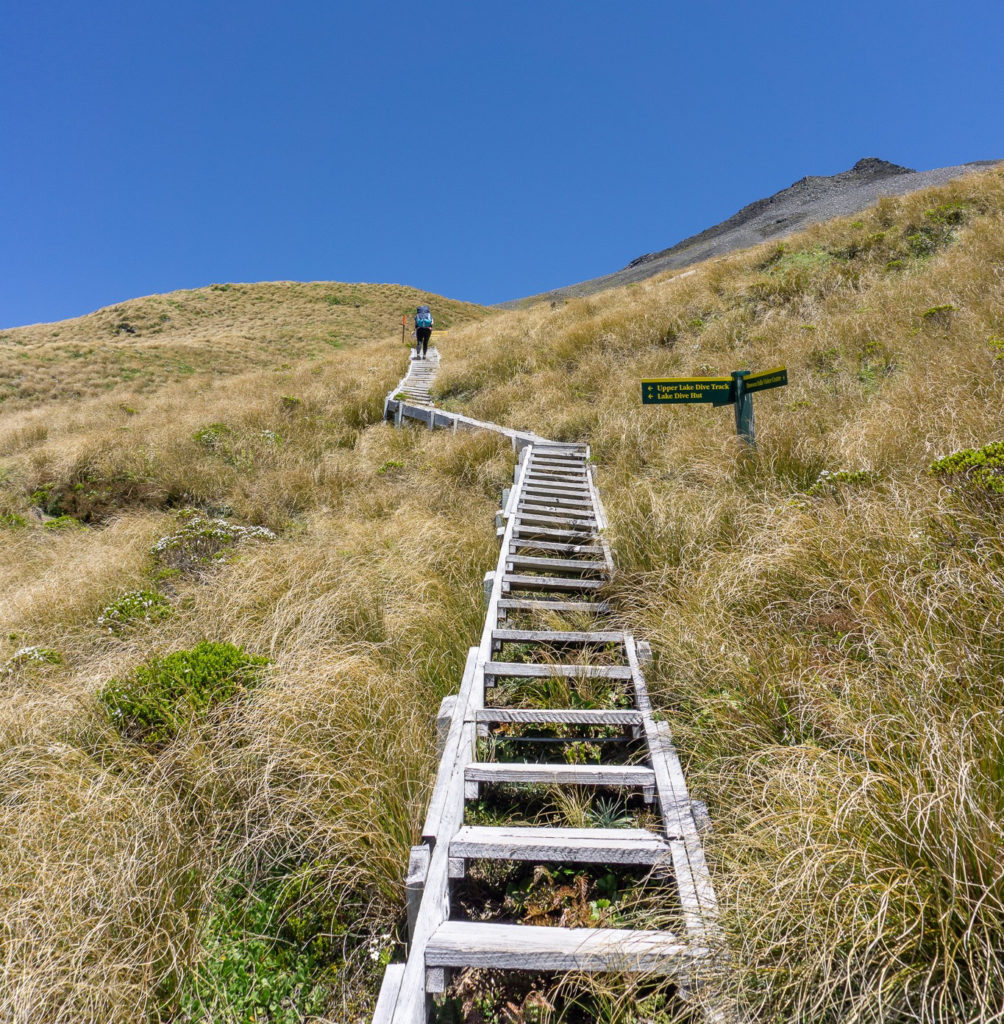
Why is it important to train?
Safety
Let’s be Debbie Downers for a second (sorry Debbie) and consider the worst case scenario in terms of your fitness:
You’re nowhere near fit enough to tackle the tramp you’ve set out on. You can’t complete the tramp and require extraction by Search and Rescue (SAR). Alternatively it takes you a lot longer than planned to reach your destination, necessitating risky travel in the dark, or exposure to the elements for longer than you have the gear for. Sounds ridiculous, but it happens more often than it should.
Reduction of injuries
Being fit enough for tramping also reduces the risk of injury. Tired and weak muscles are more likely to give way, or not compensate over rough terrain, causing soft tissue injuries or worse. Add a heavy pack to the mix, and balance comes into play as well.
Enjoyment
If you’re not fit enough for a trip, I doubt that you’ll be enjoying it as much you could. I don’t always love slogging up hills (let’s be honest, I pretty much never enjoy that), but I definitely hate it less when I’m fitter and it feels like “I’m overcoming a challenge” rather than “Why am I voluntarily doing this? It feels like I’m dying!”.
Targeted benefits
Lastly, specific training for tramping adventures means you’ll target all those muscle groups and special types of fitness you need for adventuring in the wilderness. Going to the gym everyday doesn’t actually mean you’ll be able to carry a 13kg pack over rough terrain for 6+ hours a day for three days. You need to build up endurance, balance, strength, and stamina (both physically and mentally), before you’re fully ready.
Right, you understand the importance of training, so let’s get down to it – what should we be doing to prepare for our tramps?

How do I get fit for tramping?
I’m very sad to say there isn’t a magic solution where you get to eat all the chocolate you want, work your 9-5 office job, binge-watch shows on Netflix and then be fit enough to go on adventurous hikes in the weekend (take this from personal experience). You have to put in the work – although hopefully you can find a way to make it fun so that it doesn’t seem like work.
First off, exercise is a very personal thing. Body types, metabolism, base fitness, general health – all of these factors and more can drastically differ between people. With Penzy and Ruth’s help I’ve popped some general advice and tips here, but if there’s something that’s not working for you or doesn’t fit your lifestyle, that’s completely fine – training has to work around your body and your life, not the other way around.
Set goals
We normally say “don’t run before you can walk”. In tramping lingo we could change this to “don’t go on an overnighter before you can do a long day walk”. You need to start slow and build up – this will help you enjoy your trips much more, and help keep you and your group safer.
Start with the following two questions. If the answers to them are drastically different, then it’s time to do something about it and get training!
- What is your current level of fitness?
- What level of fitness is required from your future trip?
If you’re a relative beginner then it can be really hard to judge how fit you need to be. Finding the answers to these further questions might help:
- How long will you be walking each day? Time is often a more helpful measure than distance, as it takes into account distance, terrain and elevation change, although it is subjective. Remember to look at several resources as you may find times on a given adventure vary wildly depending on the person. Penzy’s advice is that you can calculate around 4km per hour on a nice track, plus 10 minutes for every 100m of elevation gain.
- Is the trip uphill or flat? To be fair if you’re in New Zealand that question answers itself – there be hills. So better questions are: what is the elevation gain? How steep is it? (Will you need to be using your upper body to pull yourself up the mountain, as well as your legs?)
- Will you be carrying a pack? How heavy will this be?
- How fit are the other people you’re going with? Do they like to take breaks or do they like to just smash it out? Are they like Penzy and may have been training for an event where you don’t even stop to eat or drink? (shudder)
- What is the weather likely to be? Extremes of either hot, cold or sun/wind/rain exposure can make trips more difficult and draining.
Use these questions to set your goals. For example, if you’re going to be walking up a steep track, then you’ll want to be focussing on your leg strength (and potentially arms depending on how steep!), core, and cardio. If you’re going to be carrying a heavy pack, then you need to be training with a pack. If it’s a long trip, you’ll want to work on endurance.
Goals can be great motivators, so they’re important to set. Please reach out to me if you have any questions about this – you can leave a comment below or message me over on Instagram. Penzy is also happy to field questions about this – you can get in contact with her on her Instagram or her website.
Just remember that you may not always be able to reach your goals due to factors outside your control (weather, other people, breakdowns, etc.). Knowing when to bail is more important than proving you are fit enough or than reaching the summit. Don’t risk your life and others’ to prove a point.
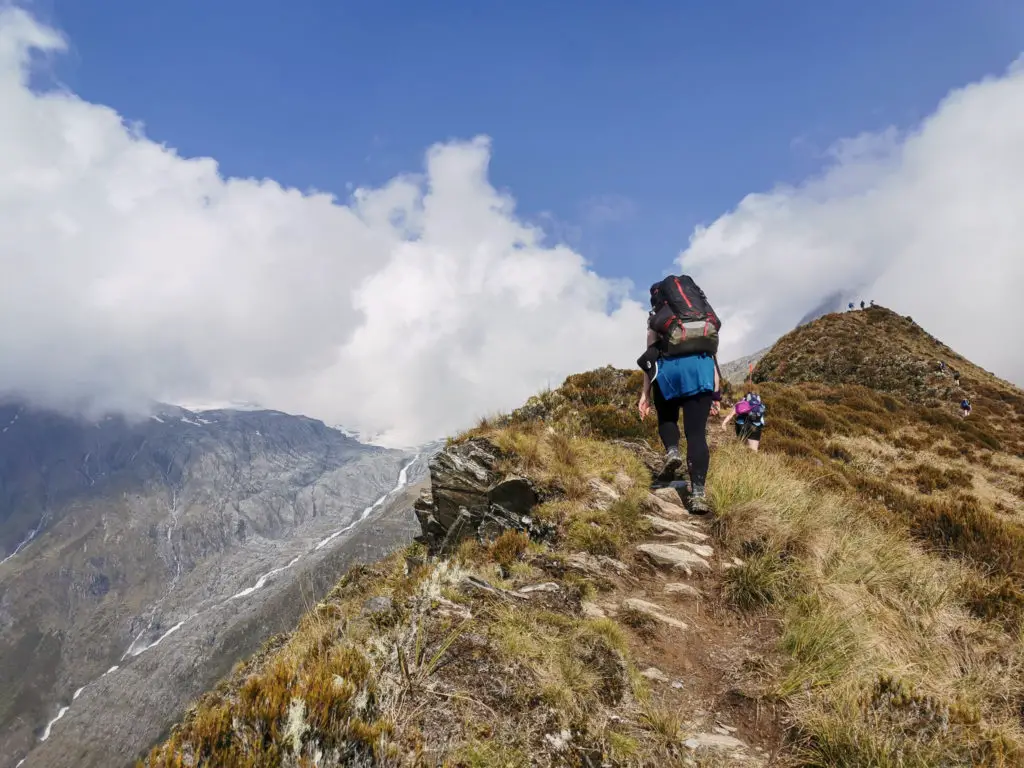
Exercise
Now that you know what you’re working towards, what should you do to help you get there? Here are some exercises to help you get fit for tramping without equipment – you should be able to do most of these at or around home. REI also has a great specific training schedule here with examples of exercises.
- Warm up
Before you do any exercise, remember to limber up your muscles to avoid injury. This may mean just going for a walk on flat or sloping ground. Or it may mean starting your exercises with reduced weight or intensity.
- Ankles
I’ve been noticing after lacing up my tramping boots for the first time in over 7 weeks and walking up more than 10 metres of incline, that my ankles are weaker than I’d like. They’re also a common injury for trampers so don’t over look them.
Physio tip: Strengthen your ankles and increase your proprioception by standing on an unstable surface like a pillow or wobble board for a few minutes each day. There are also set exercises you can complete with these, have a look around for ones that are a fit for you and your resources.
- Legs
Your legs are going to be what takes you from Point A to Point B. They should be a key focus of your training. The best way to get fit for tramping is honestly to go tramping. Start with small half-day walks and work your way up from there. However, there are some cases where it may pay to do a little more training, particularly if you’re going to be tackling some steep elevation gain.
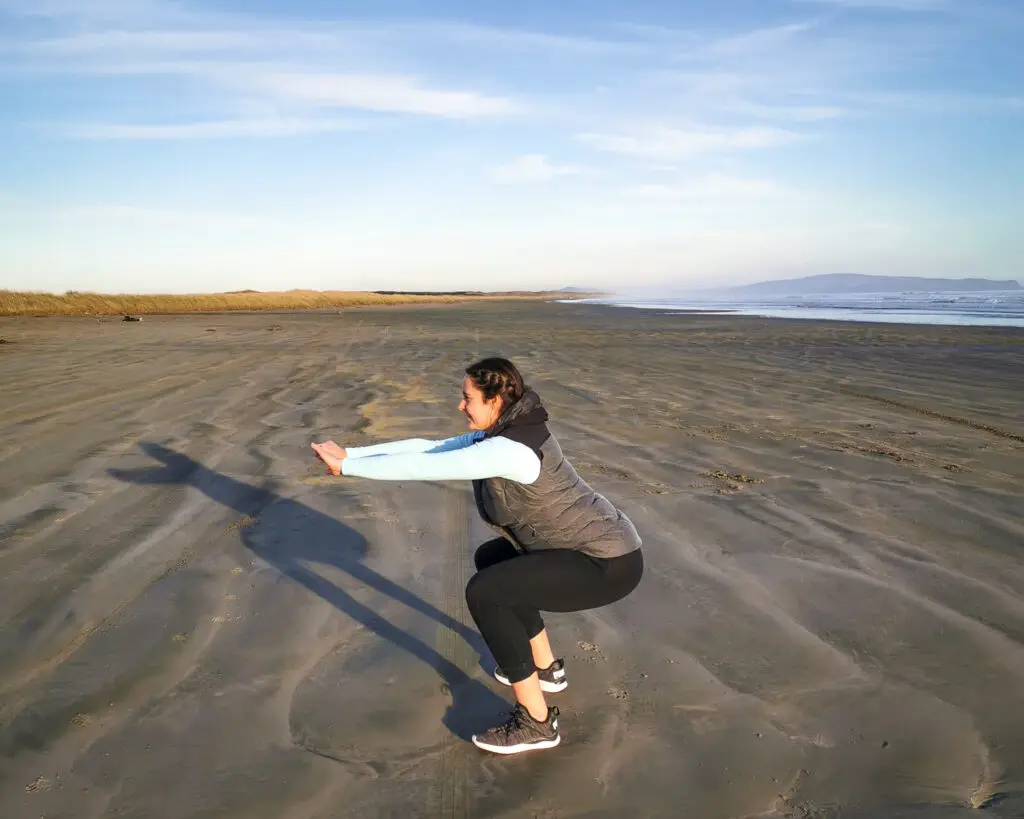
If your next trip involves 2,000+ steps (looking at you Mueller) or a very steep climb (*cough* French Ridge) with a pack then it pays to increase the strength in your legs. Squats, lunges and stair climbs (especially the jumping kinds) are my sworn enemies, but they are bread and butter for building strength in your legs. Adding a weighted pack to the mix will simulate real tramping conditions. This will also further increase your strength and balance.
If you’re stuck for time, find a local hill and challenge yourself to walk up it at speed with a heavier pack than you’ll have on the trip (obviously build up to this). This will have you feeling like you’re flying when you’re next out in the actual hills.
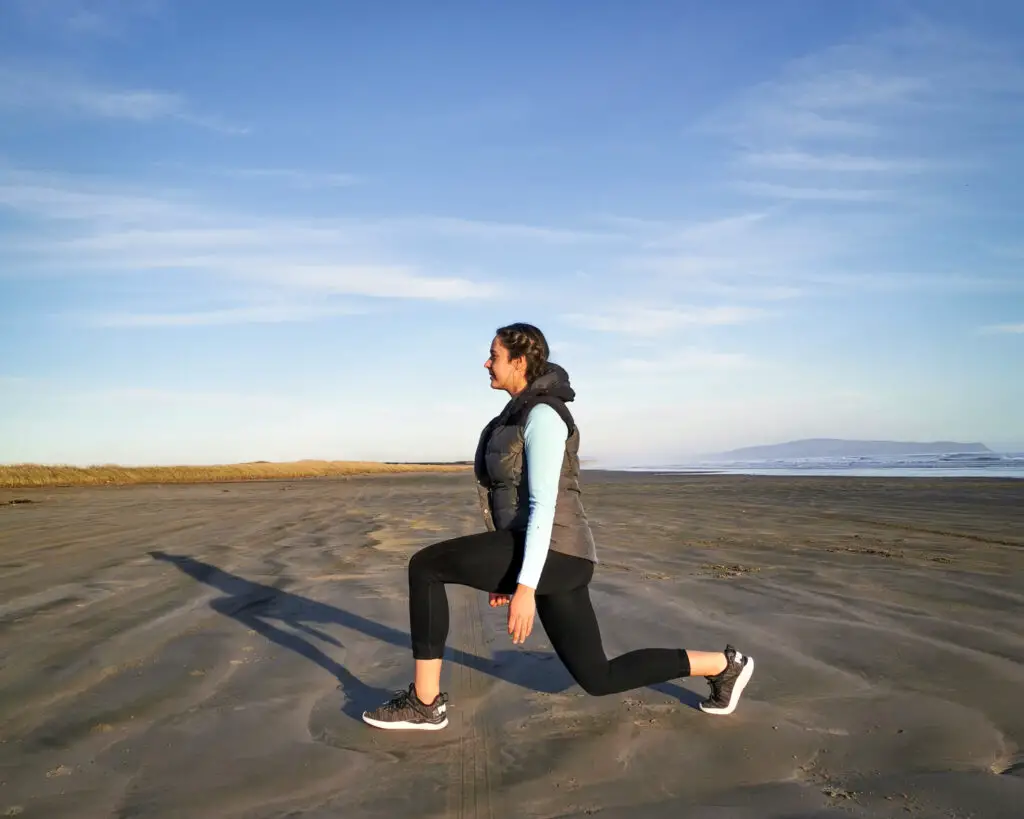
If you have known weaknesses, now it the time to work specifically on these so they won’t slow you down on your trips. For Penzy, it’s her glutes, although quads are equally important, particularly for protecting your knees. For me, it’s an old knee injury that can get really stiff post-adventures.
Be careful of your joints, particularly your knees, when you’re completing these exercises. Be especially cautious when adding more than just body weight or doing the jumping versions. If you’re having difficulty, don’t dip as low, or use extra supports like a wall sit. If you experience any pain, see a registered professional like a physiotherapist to help guide you.
Physio tip: the Achilles tendon is a potential weak point for not only its namesake Achilles, but also for trampers and trail runners. Doing calf or heel raises can help, but remember to do these off a step rather than flat ground so you’re going through the whole range of motion.
- Hips
I often get achey hip muscles after a tramp, especially when going up steep terrain with a pack sitting on them. There can be a variety of reasons for this (including low quality or ill-fitting boots and pack). Sometimes after a few trips your body adjust, but one way you can prevent this is by strengthening your glutes and core, as well as your hip flexors. Backpacker.com has some awesome exercises here that you can work on before heading out.
Physio tip: alignment is really important when completing any of these exercises, especially for the legs and hips. Remember where possible to keep your knees in line with your 2nd or 3rd toe. You don’t want knees pointing inwards or outwards too far as this will engage muscles other than your target.
- Core
Your core helps provide your stability and strength when it comes to tramping. Bicycles, leg dips, and planks are key exercises here. You can find modified versions of these online to mix things up and keep your exercise interesting. This is probably the most important area to focus on, after your legs.
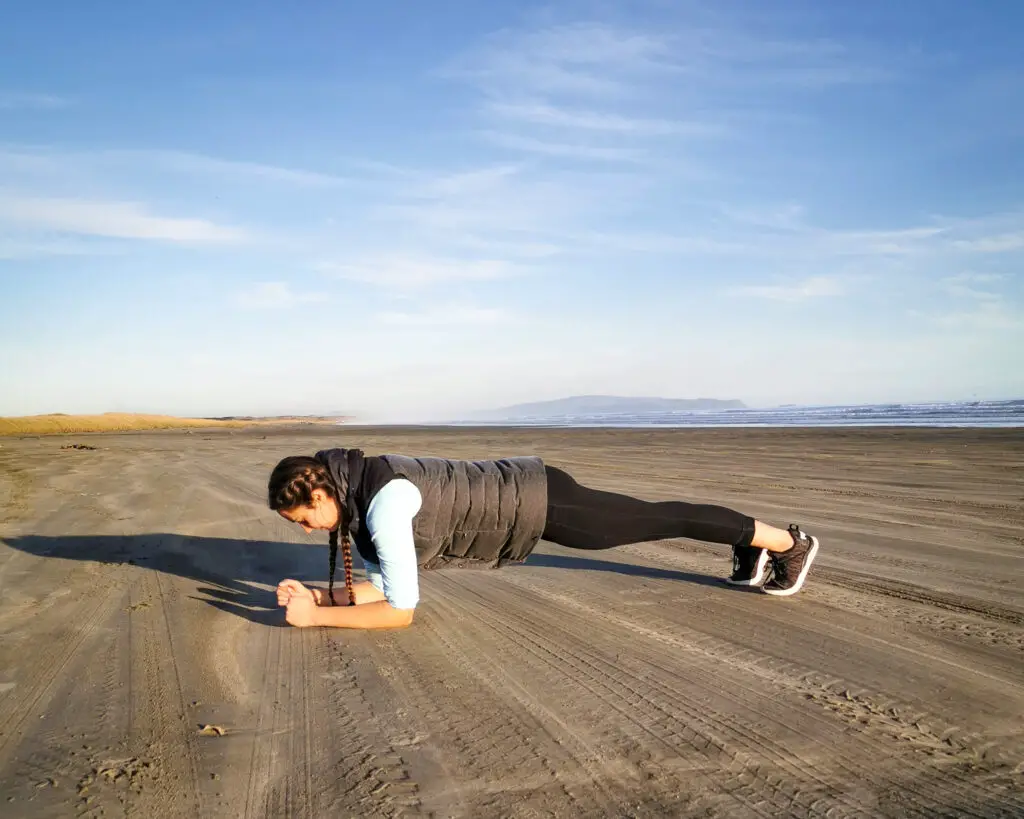
Physio tip: Without a strong and stable core, all of your other muscles will be working overtime to compensate. You’ll likely fatigue more quickly or be prone to injury. Remember to add core exercises to any training you do.
- Upper body
Working on your arms and shoulders can be useful when you’re going to be taking a heavy pack on / off, using your arms to climb up steep slopes, or using hiking poles. There are some body weight exercises that you can easily do at home, such as push-ups. I find my elbows get rather sore doing these, so I tend to fill up 2L water bottles with water and use them as make-shift weights instead.

Physio tip: Posture can be a cause of back / upper body pain or tension. Be mindful of your posture when tramping and don’t let your upper body tense up, particularly when wearing a pack. Stop and adjust your gear to achieve a better fit and take the load of your shoulders if needed.
- Balance
Balance is really important when it comes to tramping. Running or walking on rough terrain will help, but you can also work on this with specific exercises at home if it’s something you struggle with. Stand on one leg with your eyes closed for a minute or more at a time. Once this gets easier, start doing leg swings with your other leg (start with eyes open for this one) and standing on slightly uneven terrain. Remember to alternate your legs.

- Cardio
Strength alone won’t get you up those hills without puffing like the Big Bad Wolf. Doing some form of cardio will help your aerobic fitness. This can be whatever you prefer; running, briskly walking up hills, stair climbs, swimming, biking, dancing, gym classes, etc. Whatever works for you and your lifestyle. I love swimming as it definitely helps my breath control, as well as toning my muscles. But that’s just a personal preference – pick what works for you and mix it up if you’re getting bored.
Physio tip: poor breathing technique can be a problem here. Remember to employ diaphragmatic breathing where possible, you want to save your accessory muscles for when you really need them.
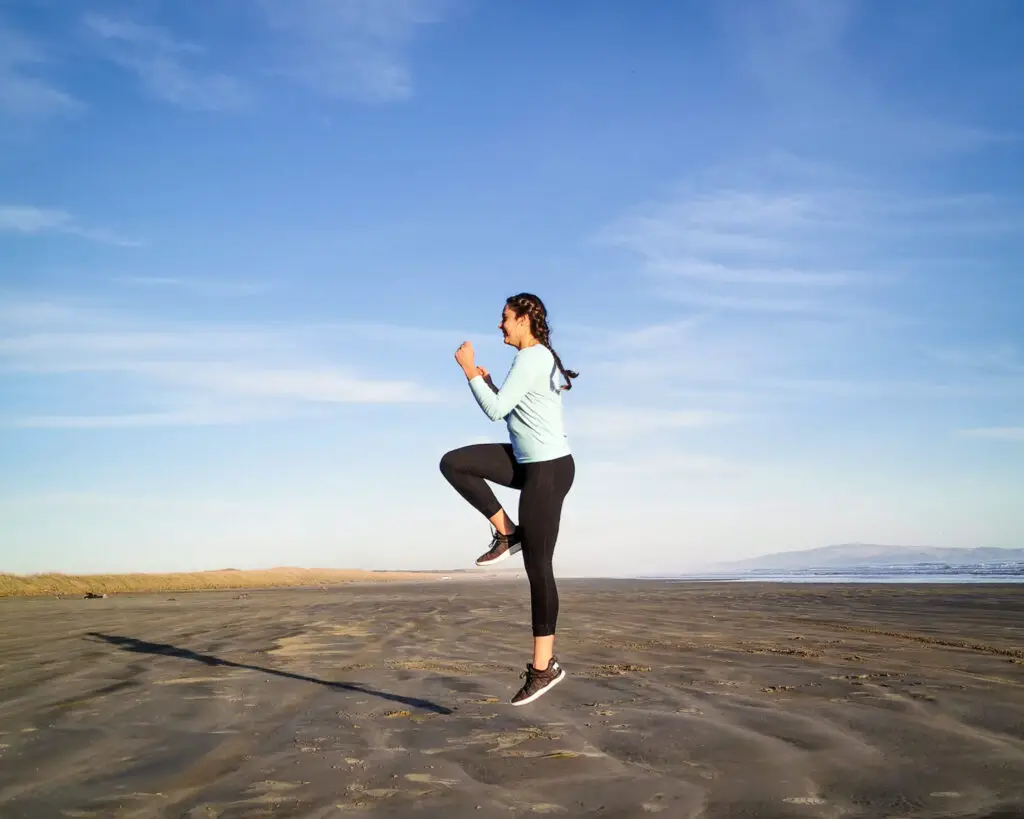
- Stretch and rest
Remember to stretch after exercise and give yourself adequate rest. Listen to your body. If it’s feeling not so great one day, take it easy and try again the next day. If something doesn’t feel right or is causing pain or strain, stop and reassess. You may need to seek guidance from a registered professional to help with any underlying issues that you’re experiencing.
Accountability and Motivation
It’s impossible to stay motivated 100% of the time (if you disagree, please let me in on your secret). The best way I’ve found is to a) have goals to work towards, like a specific tramp or adventure, b) have someone to hold you accountable, and c) mix it up.
Penzy’s training for GODZone helped her try out a whole variety of different sports as training. She says that when you change it up, training stays interesting and it’s easy to keep motivated. Changing exercises also reduces the risk of injury to any particular muscle group (although you may discover weaknesses you didn’t know you had).
Another top tip from Penzy that I wholeheartedly agree with, is that the best training for tramping is: tramping. No matter how well you’ve been training, you’ll always find the first trip after a bit of time off will be an adjustment. So don’t be too hard on yourself if the first day isn’t quite as easy as you’d hoped.
Training Tips
Wear the gear that you’ll be wearing on your tramp. That means boots, socks, the pack, everything. These all add weight and change how your body moves. This is also a chance to test out any potential gear failings prior to the actual trip. Do your shorts chaff? Does that boot and sock combination give you blisters?
Make sure your gear fits well. If it’s causing pain or strain, go and get it re-fitted. You don’t want it to be causing issues when you’re out enjoying your tramp.
If you’re going to be hiking with a pack – train with weight on your back at least some of the time. It makes a huge difference.
Sometimes you may feel like you’ve put the all work in, like you’re fit enough, but that you still aren’t having a great time when tramping. Try the following trouble-shooters:
- Make sure you are giving your body adequate nutrition and hydration during and after exercise – this is often the biggest beginner mistake.
- If you aren’t taking any rests, try taking a 5 minute rest every hour to sit down, rest your muscles and re-hydrate and eat.
- Stretch out after you reach the hut or the carpark, before you sit down and your muscles cool.
- Consider your mental fitness and resilience (more on that if you keep reading). Determination and the will to succeed play a massive role in tramping.

How do I STAY fit for tramping?
The trick to staying tramping fit is to … keep tramping. It is actually that simple.
For many people however that may not be feasible all of the time, especially over winter. Or motivation might start to take a hit and suddenly you haven’t gone on a tramp in 4+ weeks. What then?
The trick I’ve found to staying tramping fit is to find some sort of exercise that you enjoy doing. For me that’s swimming, orienteering / rogaining, and certain group exercise classes. If you enjoy doing something, it’s less of an effort and you’re more likely to continue exercising. Other examples are:
- Running, particularly trail running or stair running
- Walking over rough terrain
- Cycling
- Gym work: stair climber, elliptical etc.
- Dancing
- Yoga
- and many others!
You can also make the most of incidental exercise – take the stairs, park slightly further away, or incorporate your exercise into your daily routine. That way it’s not a chore or an “extra thing” you have to accomplish within your day. It might be as simple as standing on one leg while you brush your teeth or do your hair, or walking / biking to work instead of driving.
If lack of motivation is your problem, connecting with other like-minded people can help. Your local tramping club is great for that, as is Meetup, Got to Get Out, and various other local groups. Watch some wilderness videos or read some outdoor blogs, keep the stoke levels high!
There are also various challenges that can help boost motivation. Below are some that I personally love, but there are plenty of others online or on exercise apps that can help you stay motivated and provide daily or weekly goals. Let me know if there are any others that you’d like me to list!
- The Himalayan Trust has a summit challenge where you climb the height of Everest over a month, while raising funds for Sir Edmund Hillary’s cause.
- Wilderness Magazine runs Walk1200KM – where participants walk 1,200 kilometres at their own pace. You can register for progress trackers and join their Facebook group.
- Lots of fitness apps like Strava or Fitbit have weekly or monthly fitness challenges you can sign up for.

What about mental fitness?
No matter how physically fit you are, if you don’t build mental resilience then you’ll find tramping hard work. I’m often pleasantly surprised by friends I take on trips who I don’t think are that fit or experienced, but who take it all in their stride with seeming ease. A big part of that (I believe) is their mental fitness; their attitude and determination.
Alternatively, I’ve also taken fit friends on tramps who didn’t love the experience and who got really close to bailing out. They lacked the mental fitness, rather than the physical fitness, to make it to the end.
Penzy has had plenty of the same experiences with this, and we had a bit of a chat around why this may be.
We both think that a massive part of mental fitness is down to people’s expectations. If you go into a trip with unrealistic expectations (e.g. this 1,000m steep climb is going to be a breeze), then you’ll find it a lot more difficult to cope mentally (and physically) than if you were fully prepared. Set realistic expectations and be prepared. Some people like Penzy (and myself) also need to have a solid idea of how much more walking we’ve got and how big the next climb is going to be. If it’s bigger or longer than expected, we struggle (hence why we both like to trip plan, so we can figure this all out ahead of time). Other people don’t seem as bothered by this; they’re just walking and it doesn’t matter whether we are going up or down or by how much.
Another part is down to general personality, if you’re the type of person who can knuckle down and ignore some temporary discomfort for amazing gains, then you’ll probably love tramping. I hate walking up hills, but I love the end result – the views, sense of achievement, and the way it make my body feel afterwards – so I get it done, even when I’m not that fit.
So when you feel like your legs are about to give way. When your lungs are burning and sweat is stinging your eyes. When you’re about to give up. That’s when you dig deep. And keep going. It takes practice. You’ll still need to take breaks, make sure you have enough food and hydration, and make sure it’s safe to keep going on. But you can keep going, if you want to enough. Besides the discomfort is relatively temporary and the reward should be more than worth it when you reach the hut, or the beautiful view!
You can do this. Believe in yourself. And push through (safely).

Let me know if you’ve found this helpful, or if you have any tips I should add. Best of luck, be kind to yourself and your body, and go get tramping fit! You can do this!

Fantastic, so much helpful information and love your writing style
Thanks so much Sandy! Glad you found it useful
Great post, thanks Alice. The getting fit is definitely the hardest part! I have never trained with a pack on before, great tip. Looking forwards to getting back out on the mountains now we are in level 2. Ps, love the images, you take some absolute stunners
Thanks Anna!! Wearing a pack for training makes such a big difference, hopefully you’ll feel it too
Such an honest and well researched look into staying tramping fit. For me, tramping has always been about learning how my limits change depending on a variety of variables. The better prepared I am for the type of hike, the weather, the terrain, my gear and of course my physical/mental fitness, I find each tramping experience just gets better and better. I just need to work on getting my pack lighter now, you just can’t have too much chocolate… haha! Looking forward to our next adventure!
Thanks Grace! You can never have too much chocolate Hopefully our next adventure isn’t too far away!!
Hopefully our next adventure isn’t too far away!!
Nice, well thought out article. Thanks for sharing.
Thanks Diana! Glad it was helpful
Really enjoyed reading your article! There are 4 of us that aim to do a great walk every year. We are busy working parents, and this is our week free of those responsibilities. We have managed 3 and our 4th was canceled due to covid. I definitely have difficulty staying motivated between tramps. I generally start training specifically for it about 6 to 8 weeks out! I will put into practice some of your tips over winter!! Cheers Terese
Keeping up a routine is key, but can definitely be challenging with kids! I hope you get to do your fourth walk soon! Which one were you planning on doing?
Thank you. Your advice confirmed all that we have learned over the years when planning tramping trips and the best advice is to keep tramping and always have a plan out ahead to keep yourself motivated!
Thanks for your comment Debbie! Definitely keeping motivated is key, easier said than done sometimes!
Awesome thank you lots of great points well done!
Thanks so much for your comment Adam! Glad you found it useful